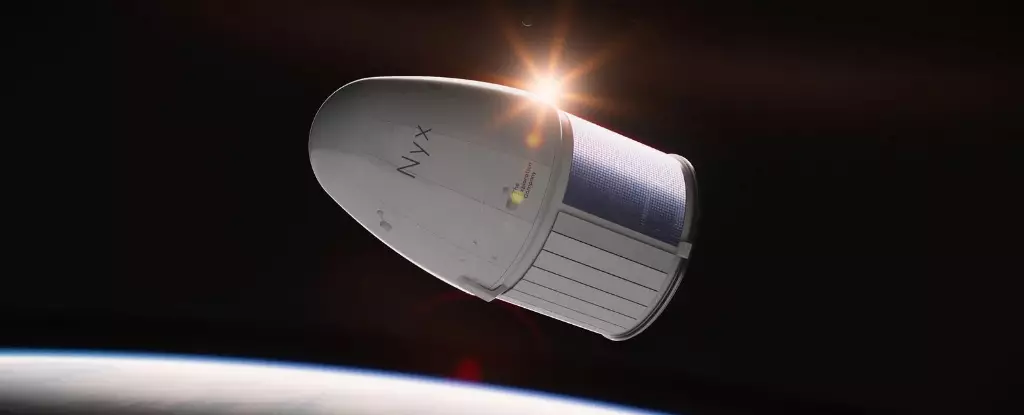Humanity’s exploration of space has always been fueled by discovery and a relentless drive to push boundaries. Since Sputnik 1’s launch in 1957, our ambitions have grown from simple orbital experiments to complex missions involving diverse payloads. The modern era of space exploration, however, is going beyond traditional scientific instruments—embracing commercialization, personal payloads, and unconventional cargo. The recent deployment of the Nyx capsule by The Exploration Company exemplifies this evolving landscape. It’s a bold step into democratizing space, offering opportunities for individuals, companies, and even life itself to reach the cosmos. Yet, with such pioneering endeavors comes inherent risk, as evidenced by the capsule’s crash-landing and the loss of valuable cargo. These setbacks underscore the importance of embracing failure as a stepping stone to success in the high-stakes world of space innovation.
Challenging the Limits: The Ambitions Behind Nyx’s Mission
The Nyx capsule’s mission represented more than just a technological test; it was a convergence of personal history, scientific potential, and entrepreneurial spirit. Sending cremated remains and DNA of over 166 individuals into space for a meaningful send-off was both a tribute and a new form of memorial. Additionally, the inclusion of cannabis seeds aimed to explore microgravity’s effects on biological material—an ambitious step toward understanding life’s resilience beyond Earth. Such experiments could hold the key to future space colonization efforts, where sustaining life in alien environments is paramount. But ambitious goals are rarely achieved without obstacles, and Nyx’s flight was no exception.
The capsule’s partial success and subsequent crash highlight the gap between aspiration and execution. According to statements from The Exploration Company, technical issues led to the failure of parachute deployment, resulting in the capsule’s loss at sea. While the launch and orbit achieved their objectives, the final moments exposed the vulnerabilities of rapid development and limited testing. It’s a stark reminder that in space technology, each component—from reentry systems to communication links—must be flawless, or the entire mission risks failure. The company’s acknowledgment of the issue and their plan to re-fly demonstrates a positive attitude toward iteration and improvement, but it also reveals the immense challenges faced by emerging space entrepreneurs.
Reflecting on Commercial Space Shipping and Ethical Concerns
The commercialization of space has unlocked opportunities previously confined to government agencies like NASA or ESA. Private companies are now not only launching satellites but also transporting personal effects, biological samples, and symbolic payloads—all at a fraction of traditional costs. While this democratization is thrilling, it also raises pressing ethical and safety questions. The fact that individuals can pay to send ashes or keepsakes into space blurs the lines between scientific exploration and personal commodification. We must ask: Are we rushing toward space tourism and memorials without fully understanding the long-term implications?
The loss of human remains, especially when families have entrusted their loved ones’ ashes to these missions, is emotionally charged. Celestis, one of the surviving companies, expressed condolences to grieving families, emphasizing that their loved ones’ remains are now part of a historic journey. Still, the fact remains that some cargo is now lost at sea or irretrievable—a nuance that should not be overlooked in the euphoric narrative of space as a new frontier. It begs us to consider whether our enthusiasm for space-based memorials and scientific experiments might outpace our readiness to manage failures responsibly and ethically.
Technological Lessons and the Road Ahead
Every failed launch or reentry attempt offers invaluable insights for the burgeoning commercial space industry. The Nyx capsule’s mishap should serve as a catalyst rather than a setback—prompting developers to refine parachute systems, improve communication protocols, and rigorously test autonomous stabilization mechanisms. Repeated failures, while disheartening, are part of the iterative process that leads to reliable space hardware capable of withstanding the unpredictable environment of Earth’s upper atmosphere.
Furthermore, the mission underscores the need for better risk management and transparency. Communication from The Exploration Company was candid about the issues faced, fostering trust with customers and stakeholders. As private companies aim to fly again, perhaps even to destinations like the International Space Station, their success will depend heavily on rigorous testing and accountability. The pursuit of innovation must be balanced with a sober understanding of safety; otherwise, the risks outweigh the benefits, and space exploration could become mired in preventable tragedies.
In the broader scope, this incident signals a crucial moment in space history: the transition from experimental flights to routine operations. The lessons learned from Nyx’s failure should inform future designs, making spacecraft more robust, redundancies more reliable, and operations safer. The long-term vision of accessible, affordable space travel hinges on continuous improvement rather than complacency.
Personal Reflection: The Courageous Imperfection of Innovation
The journey of companies like The Exploration Company embodies the very essence of pioneering spirit—embracing risks, accepting setbacks, and relentlessly striving forward. While critique is vital, it’s equally important to recognize that pushing the boundaries of space technology inherently involves trial and error. Each failure is a testament to the audacity of human curiosity and our collective willingness to explore the unknown despite the potential for loss.
This incident should serve as a catalyst for more rigorous standards but not as an obstacle to bold endeavors. The future of commercial spaceflight will depend on our capacity to learn from setbacks, innovate responsibly, and maintain a balanced perspective on risk. The path to making space accessible for personal, scientific, and commercial pursuits is paved with challenges, but it is through facing these head-on that humanity will genuinely expand its horizons and unlock the cosmos’s full potential.

